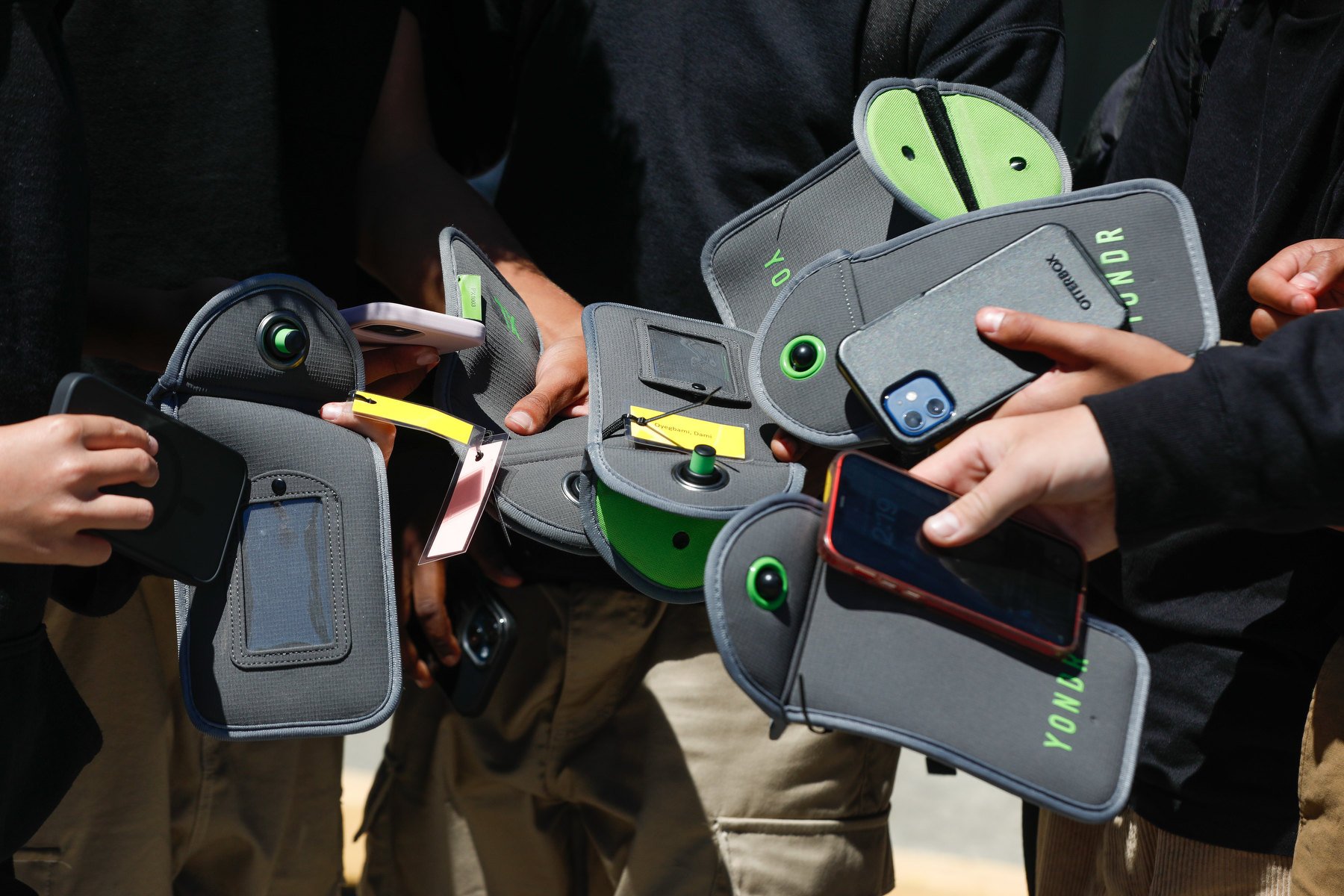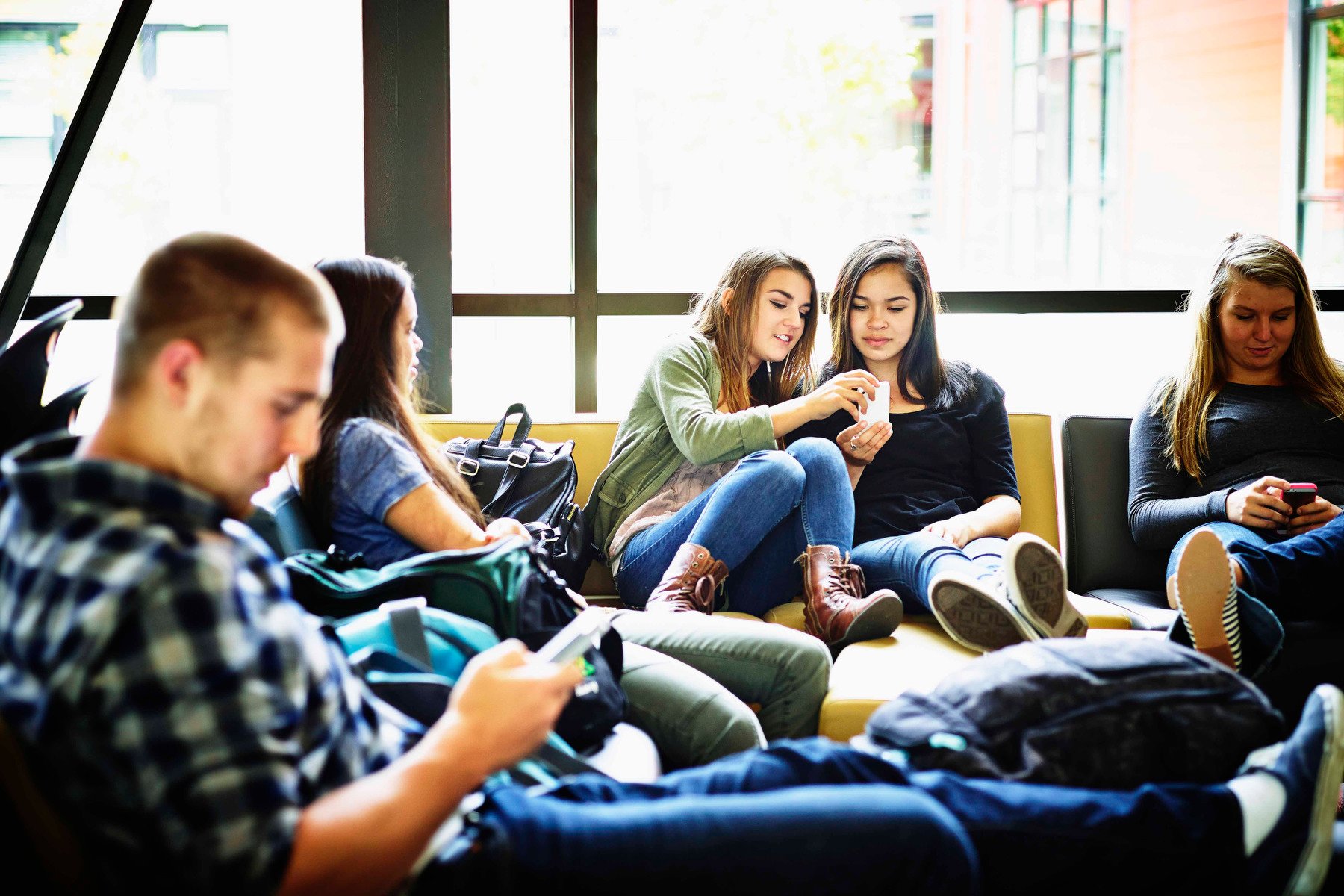Your trusted source for contextualizing education news. Sign up for our daily newsletter.
Not a school day goes by without Anthony Colla seeing a student on a phone in class. The sight is so frequent that the language and literature teacher at Eagle Rock Junior/Senior High in Los Angeles deliberates carefully before asking kids to put their devices away.
When a student’s smartphone use isn’t disrupting class, Colla often lets it slide. He intervenes “when it is a distraction to the students around them,” like when students use their phones to play video games, he said — or worse.
“I had a case of a student showing other students around him porn that he was watching, and that caused a ruckus,” Colla said. “I had to put a stop to that.”
Seventy-two percent of high school teachers and a third of teachers overall say cell phones are a major distraction in classrooms, according to the Pew Research Center. More than half of states have introduced legislation or other policies to restrict the devices in schools. Just last week, California Gov. Gavin Newsom signed the Phone-Free School Act, which mandates that all school districts, charter schools and county offices of education in the state devise plans to curb smartphone use by 2026.
Now the country’s three most populous states — California, Texas and Florida — have either introduced or enacted legislation to limit smartphones in schools. Cell phone restrictions in the fourth most populous state, New York, appear imminent; Gov. Kathy Hochul announced plans to introduce such a bill during the 2025 legislative session.
The toll of smartphones and social media on the emotional and academic wellbeing of young people, particularly girls, is a major reason lawmakers across partisan lines have supported these restrictions. Though some parents and educators believe that bans alone won’t make students less distracted or depressed, others back legislation barring phones in schools.
Julie Scelfo, founder and executive director of Mothers Against Media Addiction (MAMA), is one of them. She established the national organization earlier this year around the idea that screens are stealing children’s youth by preventing them from focusing, playing and learning, and making it difficult for educators to teach.
“There’s a national crisis in youth mental health and when you look at the source of that crisis, there’s many overlapping factors, but one of the big ones is that our children are glued to their screens, and they are spending too much time interacting not with humans, not with adults, not with nature, not with their peers and their friends outside, but with screens,” Scelfo said. To her, the use of smartphones in schools is one example of screen time displacing “critical in-person interaction.”
Multiple studies have linked smartphones and social media to mental health problems resulting in poorer academic performance and cognitive control. One study found that between 2008 and 2015, when smartphones first became popular, hospital visits related to suicide attempts or suicidal ideation nearly doubled among children and teens, primarily teenage girls. Just perusing Facebook for 10 minutes led to a decline in mood for female participants, found one randomized 2015 study. Some even wanted to alter their physical appearance after browsing the social network.
In June, U.S. Surgeon General Vivek H. Murthy wrote an opinion piece for The New York Times calling for warning labels to appear on social media platforms due to their harmful effects on teen mental health. It’s something that Scelfo, a former Times journalist who has reported on youth suicide and media addiction, endorses.
“There’s a lot of incentive for a handful of tech companies that are making insane profits to just keep doing business as usual and convincing everybody that they need to be online all of the time,” she said. “If a parent knew that a device came with a risk of their child being depressed or feeling suicidal, who would buy that toy for their kid?”
As a teacher and a union representative who hears the concerns of fellow educators, Colla has directly and indirectly seen how smartphones contribute to student-on-student bullying and body image issues for girls. At the same time, though, he’s concerned that teachers will be liable for replacing lost or damaged cell phones if they’re tasked with policing them. He’s also uncertain if a ban will dramatically improve student outcomes — emotionally or academically.
Before Newsom signed the Phone-Free School Act, the Los Angeles Unified School District, which includes Colla’s high school, approved a policy to prohibit cell phones during the school day starting in January. And that led him to consider how students might find other ways to connect to social media.
“They’re required to have a computer every single day for every single class, so they don’t post to Instagram or Snapchat or Facebook using their smartphone. Instead, they use their laptop, right? What have we done? What have we accomplished?” he asked.
Reports from Orange County Public Schools in Florida, where cell phones are banned throughout the school day, suggest that students are learning better and staying more focused without the devices.

However, Shari Camhi, superintendent of Baldwin Union Free School District in Baldwin, New York, does not support prohibiting cell phones in schools outright, even though her district of about 4,300 students is phone-free in grades K-8. High school students may use their devices during lunch and other free time, a compromise that echoes the arguments of Change.org petitions created by youth nationwide who agree that cell phones are distracting in class, but want access to them during non-instructional times.
“Cell phone usage is a larger issue outside of school than it is inside of school,” Camhi said. “The majority of issues that we see that are related to social media are happening over the weekend or during school breaks, and I don’t know that the solution to the problem is banning cell phones.”
Thirty percent of teachers in schools with cell phone restrictions say these policies can be difficult to enforce, with 60 percent of high school teachers reporting challenges, according to the Pew Research Center. Educators need families to help them ensure that children use cell phones responsibly, but that can be trying, as some parents habitually text or call their kids during the school day, Camhi said.
An online poll of over 1,500 parents of public school K-12 students conducted from Aug. 29 to Sept. 2 by the National Parents Union (NPU) — a woman-led organization made up of parent advocacy groups — found that 78 percent of parents who want their children to have cell phones say they do in case of an emergency at school. Fifty-eight percent of such parents want their children to have cell phones so they can get in touch with them or learn their whereabouts when needed while 48 percent say cell phones help them coordinate transportation to and from school with their children. Nearly as many say children need mobile devices to communicate about their mental health or other needs.
Jaquetta Lee, a mother of two and an urban farmer in Detroit, is not one of the parents pushing for her school-age child to use his cell phone during the school day. Detroit Public Schools prohibits use of cell phones during class, and Michigan lawmakers have introduced legislation to require districts to develop policies limiting use of the devices. Lee said the phone-free trend has her complete support.
“You don’t need a phone at school,” said Lee, who is active in the NPU. “It’s less concentration, it’s less focus. I’m dealing with a child who has inattentive ADHD, so I need for him not to be on certain devices to keep his head focused.”
She gave her son, a ninth grader, his first cell phone when he was in seventh grade, but Lee has urged him to use the device sparingly. She has explained to him the danger of media addiction, which has helped him understand why he should limit his time on the phone, Lee said. Instead of staring at a screen, he listens to Miles Davis, takes long bike rides and plays card games like Uno with his family, Lee said.
At Camhi’s district, the PTA organized a “game day” last spring, where students put away their devices and played hopscotch and punchball and jumped rope.
Her district is also giving students media literacy training, where they learn to distinguish fact from fiction online and how social media platforms populate users’ feeds based on their apparent interests.
“When you learn to drive, you take a driver’s test before you’re ever allowed to drive a car. Somehow we hand kids a $1,500 device with no security and no instruction and no understanding, and that opens up a tremendous world out there that can be great or it can be dangerous and harmful,” Camhi said.
For Scelfo, however, the challenge goes beyond educating kids. It includes enlisting adults to intervene and stop tech companies from perpetuating youth dependence on media.
“What we know is a product designed to be as addictive as possible. We adults are addicted. I’m addicted. Almost no adult can help themselves when they start using social media,” Scelfo said. “At the same time, I think the responsibility lies with us adults to ensure that our children…grow up without being exploited by a handful of companies for profit.”





